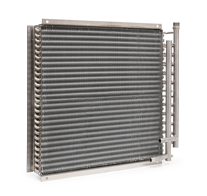In the fuel cell industry, regulating and removing the heat generated in the power production process within the fuel cell is a real challenge. The reason for that is that fuel cells use corrosive fluids or gases at high temperatures.
Therefore, when one needs to characterize a heat exchanger for fuel cells, the heat exchanger should be one that can do what is thermally necessary, but also needs to withstand high temperatures of gases and fluids and to be resistant to corrosive gases and fluids.
Many fuel cell systems convert hydrogen into electrical energy. The hydrogen source can be natural gas, ammonia, industrial emissions, etc. The gases’ temperature can range between 700 and 70 degrees Celsius, and can be the result of either an external combustion source or the temperature necessary for the process.
The fluids used in fuel cell systems are either corrosive or extremely corrosive. The most common are deionized water or 30% KOH.
Heat exchange under such conditions is a real challenge, as the heat exchanger needs to be highly efficient. A fuel cell heat exchanger must be suitable for use with high temperatures and with corrosive fluids and gases.
In order to plan and produce a heat exchanger that can withstand such conditions, one would need a tube fin heat exchanger made of stainless steel. In most cases, this would be a custom made heat exchanger, and its planning would take into account all of the working conditions required of it: on one hand, a corrosive gas at a high temperature with appropriate throughput and a minimal pressure gradient. On the other hand, a corrosive fluid (deionized water or KOH) with high throughput and a minimal pressure gradient.
We at Thermogym specialize in planning and producing custom made stainless steel heat exchangers that can work with corrosive gases and fluids at high or low temperatures.
Learn more about our custom heat exchangers
Learn more about stainless steel heat exchangers
See our full range of catalog heat exchangers


